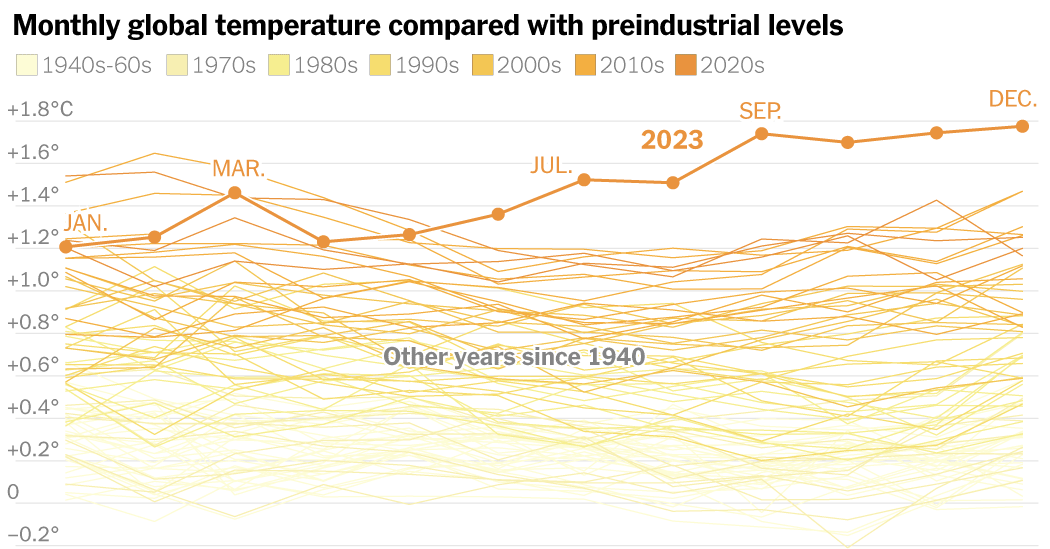The numbers are in, and scientists can now confirm what month after month of extraordinary heat worldwide began signaling long ago. Last year was Earth’s warmest by far in a century and a half.
Global temperatures started blowing past records midyear and didn’t stop. First, June was the planet’s warmest June on record. Then, July was the warmest July. And so on, all the way through December.
Averaged across last year, temperatures worldwide were 1.48 degrees Celsius, or 2.66 Fahrenheit, higher than they were in the second half of the 19th century, the European Union’s Copernicus Climate Change Service announced this week. That is warmer by a sizable margin than 2016, the previous hottest year.
On Friday, scientists at NASA similarly found the global average temperature in 2023 was about 1.37 degrees Celsius higher than preindustrial levels, while according to the National Oceanic and Atmospheric Administration, last year was 1.34 degrees Celsius warmer than the preindustrial average.
Each organization uses different methods to calculate their numbers. But all agree that 2023 was the warmest year on record by a wide margin.
“This is a big jump,” said Russell Vose, chief of climate monitoring and assessment at the NOAA National Centers for Environmental Information, during an event announcing the agency’s results on Friday.
It comes as no surprise to climate scientists that unabated emissions of greenhouse gases caused global warming to reach new highs. What researchers are still trying to understand is whether 2023 foretells many more years in which heat records are not merely broken, but smashed. In other words, they are asking whether the numbers are a sign that the planet’s warming is accelerating.
When scientists combine their satellite readings with geological evidence on the climate’s more distant past, 2023 also appears to be among the warmest years in at least 100,000, said Carlo Buontempo, director of the European Union climate monitor, on Tuesday. “There were simply no cities, no books, agriculture or domesticated animals on this planet the last time the temperature was so high,” he said.
Every 10th of a degree of global warming represents extra thermodynamic fuel that intensifies heat waves and storms, adds to rising seas and hastens the melting of glaciers and ice sheets.
Those effects were on display last year. Hot weather baked Iran and China, Greece and Spain, Texas and the American South. Canada had its most destructive wildfire season on record by far, with more than 45 million acres burned. Less sea ice formed around the coasts of Antarctica, in both summer and winter, than ever measured.
“We need to be prepared for the impacts of climate change that are happening here and now, like extreme events that are becoming more frequent and severe,” said Sarah Kapnick, NOAA’s chief scientist, at Friday’s event. Dr. Kapnick said she hopes communities, businesses and individuals use the data released by her agency and others to prepare and build resilience for the future.
Under the 2015 Paris Agreement, nations agreed to limit long-term global warming to 2 degrees Celsius, and, if possible, 1.5 degrees. At present rates of greenhouse gas emissions, it will only be a few years before the 1.5-degree goal is a lost cause, researchers say.
Carbon dioxide and other greenhouse gases are the main driver of global warming. But last year several other natural and human-linked factors also helped boost temperatures.
The 2022 eruption of an underwater volcano off the Pacific island nation of Tonga spewed vast amounts of water vapor into the atmosphere, helping trap more heat near Earth’s surface. Recent limits on sulfur pollution from ships brought down levels of aerosols, or tiny airborne particles that reflect solar radiation and help cool the planet.
Another factor was El Niño, the recurrent shift in tropical Pacific weather patterns that began last year and is often linked with record-setting heat worldwide. And that contains a warning of potentially worse to come this year.
The reason: In recent decades, very warm years have typically been ones that started in an El Niño state. But last year, the El Niño didn’t start until midyear — which suggests that El Niño wasn’t the main driver of the abnormal warmth at that point, said Emily J. Becker, a climate scientist at the University of Miami.
It is also a strong sign that this year could be hotter than last. “It’s very, very likely to be top three, if not the record,” Dr. Becker said, referring to 2024.
Scientists caution that a single year, even one as exceptional as 2023, can tell us only so much about how the planet’s long-term warming might be changing. But other signs suggest the world is heating up more quickly than before.
About 90 percent of the energy trapped by greenhouse gases accumulates in the oceans, and scientists have found that the oceans’ uptake of heat has accelerated significantly since the 1990s. “If you look at that curve, it’s clearly not linear,” said Sarah Purkey, an oceanographer with the Scripps Institution of Oceanography at the University of California, San Diego.
A group of researchers in France recently found that the Earth’s total heating — across oceans, land, air and ice — had been speeding up for even longer, since 1960. This broadly matches up with increases in carbon emissions and reductions in aerosols over the past few decades.
But scientists will need to continue studying the data to understand whether other factors might be at work, too, said one of the researchers, Karina von Schuckmann, an oceanographer at Mercator Ocean International in Toulouse, France. “Something unusual is happening that we don’t understand,” Dr. von Schuckmann said.
Delger Erdenesanaa contributed reporting.



